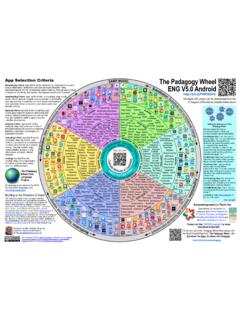Transcription of App Selection Criteria The Padagogy Wheel V4
1 Remembering: Apps that fit into the "remembering" stage improve the user's ability to define terms, identify facts, and recall and locate information. Many educational apps fall into the "remembering" phase of learning. They ask users to select an answer out of a line-up, find matches, and sequence content or input answersApplying: Apps that fit into the applying stage provide opportunities for students to demonstrate their ability to implement learned procedures and methods. They also highlight the ability to apply concepts in unfamiliar : Apps that fit into the "analysing" stage improve the user's ability to differentiate between the relevant and irrelevant, determine relationships, and recognise the organisation of : Apps that fit into the "evaluating" stage improve the user's ability to judge material or methods based on Criteria set by themselves or external sources.
2 They help students judge content reliability, accuracy, quality, effectiveness, and reach informed : Apps that fit into the "creating" stage provide opportunities for students generate ideas, design plans, and produce products. Developed by Allan Carrington Designing Outcomes Adelaide South Australia Email: Padagogy Wheel Published 010315 Standing on the Shoulders of GiantsRemembering CriteriaApplying CriteriaUnderstanding CriteriaEvaluating CriteriaCreating CriteriaThis taxonomy Wheel , without the apps, was first discovered on the website of Paul Hopkin s educational consultancy website That Wheel was produced by Sharon Artley and was an adaption of Kathwohl and Anderson s (2001) adaption of Bloom (1956). The idea to further adapt it for the pedagogy possibilities with mobile devices, in particular the iPad, For and I have to acknowledge the creative work of Kathy Schrock on her website Bloomin Apps For the major revision that is I have to thank the team of ADEs who created APPitic the App Lists for Education Project which has now closedAnalyzing : Apps that fit into this "understanding" stage provide opportunities for students to explain ideas or concepts.
3 Understanding apps step away from the Selection of a "right" answer and introduce a more open-ended format for students to summarise content and translate Selection Criteria The Padagogy Wheel Padagogy Wheel by Allan Carrington is licensed under a Creative Commons Attribution-nonCommercial-ShareAlike International License. Based on a work at Padagogy Wheel First Language Project: 21 languages are planned for 2016. For the latest languages see Immersive Learning at the core of the Wheel is the New Instructional DesignKeynoteMental NoteNotepad+BlogpressiAnnotateiBooksSoni c PicsShow MeVoice ThreadEvernoteNotabilityEducreationsiTun esUKodablePrezineu+NotesTwitterPolaris OfficeSmart Office 2 PowerPointGoogleGoogle DocsWikipanionPuffin BrowserExelWordQuick SketchFlashcard MachineFlashcards DeluxeQuiz Your LizardAwesome NoteI WishFlipBoardWolframAlphaMaptiniInspirat ion MapsPagesMulti QuizWunderListStumbleUponKidspirationAnn s FlashcardsiThoughtsHDPoppletSnap the NotionBitsboard ProAssignmentsCorkulousCourse NotesData AnalysisEasy ChartIdeamentiStudiez PromyHomeworkNotes PlusOutlinerPenultimatePolldaddyPriority MatrixQuick GraphSimple NoteUse Your HandwritingBig
4 WorldDropboxNumbersPearltreesSimpleminds +BlackboardClear SeaMoodle MobileSkypeEdmodoFringWhatsAppFacebookFB MessengerGoogle+iTunes UTo u c hYo u Tu b eStrip DesignerFilemaker Go 14 GroupBoardiBrainstormRoambi AnalyticsTEDO pera MiniJotAudioBoomToontasticFlipbookDo InkiMovieExplain EverythingGaragebandCreative BookShowbieHalftone 2 ChatterPixPhotogeneWriter s StudioPictelloRecordium ProPhoto RemindersStory CreatorPic CollagePixelmatorPuppetPals 2 Doodlecast ProEasyStudioBookCreatorWebAlbumsVideoSh opShadowPuppetiStopMotionConference PadWordpressMicrosoft OneNoteiDesignPaperHelper2 ScreensPresentation TimerScreen ChompTwitterrificDrawingPadFeeddlerSimul ations are the most effective pedagogy to develop graduate attributes and capabilities in learners, as well as address motivation. Please visit these Immersive Learning Resources which will help you design and build engaging experienced-based immersive the best use out of the Padagogy Wheel Use it as a series of prompts or interconnected gears to check your teaching from planning to implementation The Attributes Gear: This is the core of learning design.
5 You must constantly revisit things like ethics, responsibility and citizenship. Ask yourself the question what will a graduate from this learning experience look like what is it that makes others see them as successful? Ask how does everything I do support these attributes and capabilities? The Motivation Gear: Ask yourself How does everything I build and teach give the learner autonomy, mastery and purpose? The Blooms Gear: Helps you design learning objectives that achieve higher order thinking. Try to get at least one learning objective from each category. Only after this are you ready for technology enhancement. The Technology Gear: Ask How can this serve your pedagogy ? Apps are only suggestions, look for better ones & combine more that one in a learning sequence. The SAMR Model Gear: This is How are you going to use the technologies you have chosen ?
6 I would like to thank Tobias Rodemerk for the idea of the gears. Tobias is a teacher & works for the State Institute for School Development Baden-W rttemberg (LS), Germany Allan CarringtonAttributesBloomsSAMRM otivationEdtech


